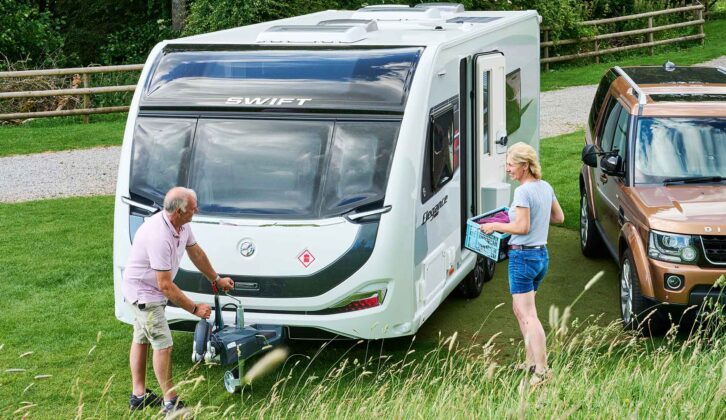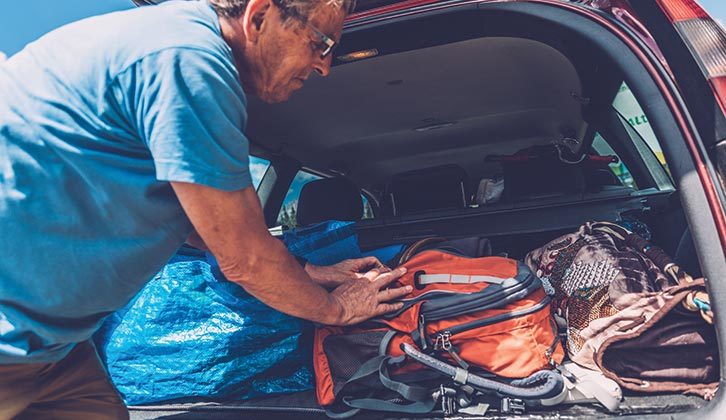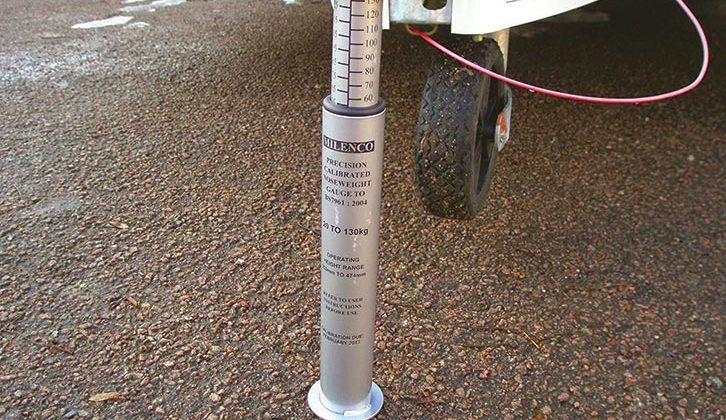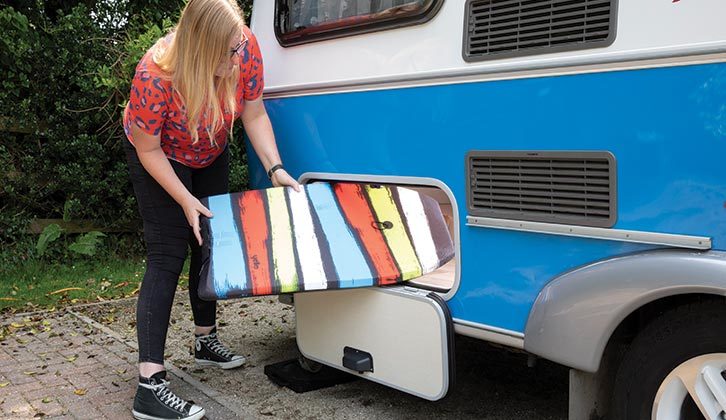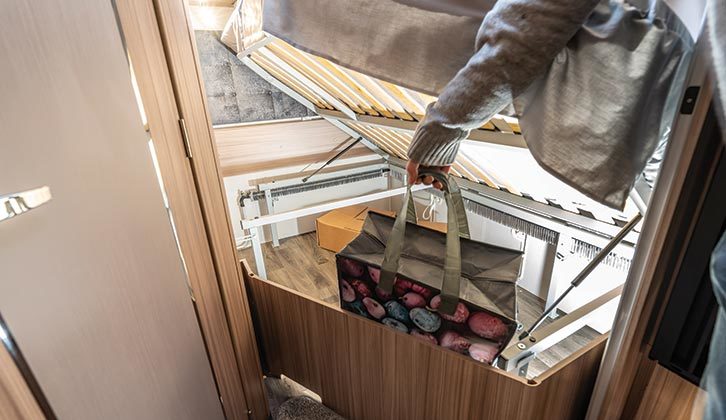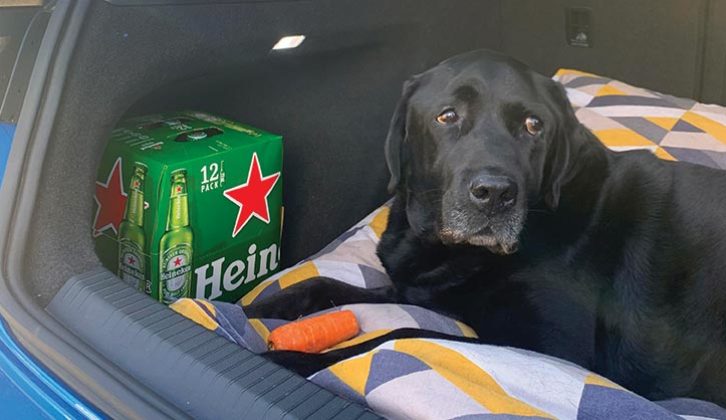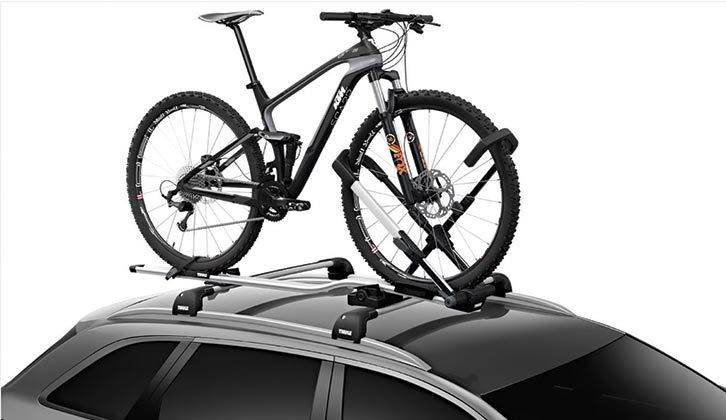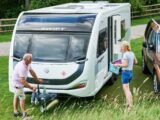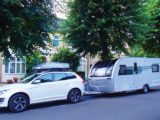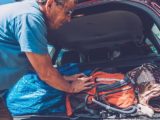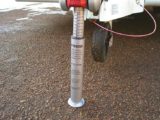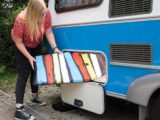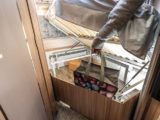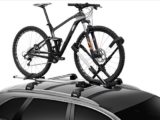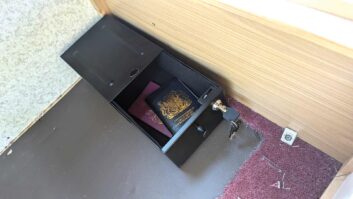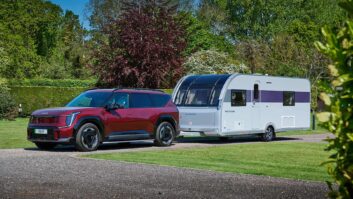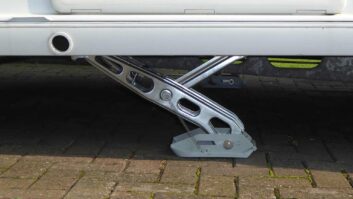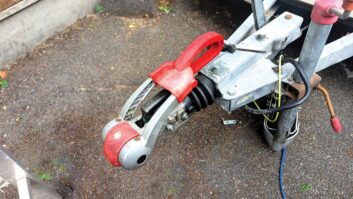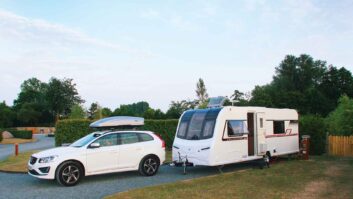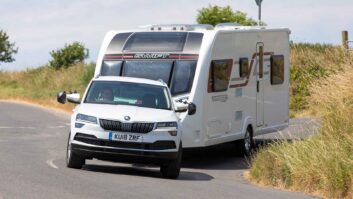The phrase ‘It’s not what you do, it’s how you do it’ applies very well to caravan loading. Most caravanners know of the 85% guidance for car and van matching, but there’s a lot more to safe and stable towing than following this advice.
The weight of what you load in your caravan is important. Where you put this weight is just as vital. The best caravans nowadays are full of useful and innovative storage options, including overhead lockers, external hatches, and underseat and underbed spaces. In addition, if you’re canny with your tow car choice, you can use that to carry extra kit and distribute the weight more safely, so you don’t have to worry about leaving any caravan essentials behind.
Follow these tips to make sure both you’re sensibly loading your tourer and car to help you safe on the road, whether you’re towing a caravan a long distance or embarking on a tour closer to home.
Practical Caravan is supported by its audience. When you purchase through links on our site, we may earn an affiliate commission. Learn more
Loading a caravan: what you need to know for safe towing
Don’t overload your caravan
Shifting some weight
Check how much your caravan weighs
Balancing act
Stopping movement
The importance of noseweight
Picking a car
Transporting pets
Additional storage options for caravans
Don’t overload your caravan
A key starting point is understanding the various caravan weights. Start by determining your van’s MTPLM (the maximum weight it can be towed at) and MiRO (its empty weight, which includes a gas bottle and fluid allowance – but, strangely, not the leisure battery). The difference between the two figures is your allowable payload: the weight of clothes, food, pots and pans and so on that you can carry in the van when you are towing.
Typical family caravans might have a MiRO of 1400kg and an MTPLM of 1550kg. This gives you a payload of 150kg. While that sounds like a lot, it is soon eaten up.
For example, if you transport an awning at, say, 35kg, and you have also had one of the best caravan motor movers fitted, weighing about the same, that’s almost half your allowance gone already. Add your leisure battery at 12kg and a bag of clothes for each person at 15kg, and you are almost at your limit – and that’s before you add food, drinks, a TV and caravan crockery.

This illustrates the challenges we face, especially heading off for longer breaks.
To raise the stakes further, it has been known for the police to set up temporary weigh-station checks at motorway services (particularly on the M5 and around the west country in summer), to carry out random checks on caravanners.
Those found to have transgressed the weight rules are obliged to reduce the mass of their tourer by removing items before they travel any further. Not the best way to start your holiday! So we have to be smart about our packing, and that’s where our handy advice comes in.
Shifting some weight
For starters, we can alleviate part of the kilogram conundrum by moving a portion of the weight out of the caravan and into the tow car.
I always start with the awning, which I put in the boot right behind the back seats, so that the weight is over the axle. It fits neatly and frees up a big chunk of useful payload.
I also transport our caravan barbecue and patio gas cylinder in the car. That still leaves plenty of room for my camera bag and other valuables in the security of the car.
Check how much your caravan weighs
It’s a tedious task, but you can check that you will remain within the payload by weighing everything you plan to pack in the caravan beforehand.
Weigh each bag and container on bathroom scales, either on its own or by standing on the scales holding the bag, then subtracting your weight.
Add up the total and then take out any non-essential items until you are within the payload weight.
Alternatively, you could take your loaded caravan to a public weighbridge. However, the first method carries less risk of inadvertently towing while the van is overloaded.
There’s also the car/caravan matching to consider. Depending on your car and tourer, the car’s 85% match figure may be less than the caravan’s MTPLM. It’s usually recommended that the loaded weight of the caravan does not exceed 85% of the tow car’s kerbweight for the sake of stable towing, especially for drivers new to towing.
You may need to stay a few kilos under the van’s MTPLM to achieve the 85% matching ratio.
Balancing act
Loading your caravan has to be done with weight distribution very much in mind. There are some simple rules to apply:
- Be sure to store heavier accessories on the floor of the caravan. This maintains a low and stable centre of gravity and also negates the risk of more weighty items falling out of the overhead lockers, which could result in damage.
- The heaviest items should be placed close to, or right over, the axle in the middle of the tourer. By doing this, you should eliminate any see-sawing effect when towing.
- Caravans should be slightly nose-heavy on the road, as this delivers the most stable and controllable tow. Usually, the weight of items in the front locker (gas bottles and so on) will deliver this.
- The noseweight is ideally 5-7% of your caravan’s laden weight, and is measured with a noseweight gauge. Otherwise, at a push, you can use bathroom scales on the ground under the tow hitch, with a piece of wood located in between.
- Many island-bed caravan layouts have a huge storage space under the double bed at the back of the caravan. You should load bulky, but not heavy, items in here, as excessive weight in this position is likely to cause a pendulum snaking effect. Things such as duvets and sleeping bags are ideal for being stored under the bed.

- While it is not crucial, try to keep your load roughly even on each side of the caravan, bearing in mind that there’ll be a heavy battery on one side.
- Underseat storage space is often very useful in tourers, but always pack your most-used belongings where they are going to be easy to access.
- External lockers are particularly useful on beach holidays, because wet and sandy gear (bodyboards and deflated dinghies) can be securely stored in them without being traipsed through the van.
- We like to use those blue Ikea bags for carrying our clothes when we head off in the caravan. They are capacious, cheap, lightweight and strong, and last forever. We each take one and they will handily squash into underseat storage spaces.
Stopping movement
Something else that’s easy to overlook is that loads can shift during a journey. For example, heavy braking can move items towards the front of the van.
To prevent this from happening, you can use non-slip mats and shelf liners.
Cargo bars would also be a wise precaution. These can be positioned across the caravan floor, braced on either side to avoid the risk of any unwanted movement.
If any towing emergencies have occurred and you do need to make an emergency stop during a journey, it’s a sensible precaution to stop in the next layby or motorway services to check the load and reposition items if necessary.
The importance of noseweight
Although most caravanners know that matching ratios make an important contribution to stable towing, the value of noseweight can be underestimated.
The noseweight or download on the towball should ideally be 5-7% of the loaded weight of the caravan. So for a caravan weighing 1400kg, the download on the ball should be 70-98kg. Your tow car will have a maximum towbar download, just to make things more complicated. This shouldn’t be exceeded, even if it is less than 5%. Some cars have a noseweight limit that’s just 4% of the towing capacity.
You can check the noseweight using a noseweight gauge – your local caravan dealer should be able to sell you one. Alternatively, a length of wood and some bathroom scales can do the job. Be sure to measure the noseweight on level ground, with the caravan loaded as it would be to travel.
If the noseweight is too heavy, move some items back slightly. Just be careful not to go too far, with excessive weight towards the back of the caravan. Move just a few items a short distance and check each time, until the desired noseweight is achieved.
Don’t forget the car
Choosing the best tow car for your needs will be a crucial part of an enjoyable experience on the road – after all, you will also be loading it up too. Just like a caravan, your car will have a payload. Take care that it isn’t exceeded. Remember to take account of the weight of your passengers – a car full of adults will weigh a lot more than two grown-ups with young children.
If you are unsure how heavy your car can be, check the weight plate, usually found inside one of the doors. The first figure is the gross vehicle weight, the motoring equivalent of the MTPLM. Once full of people and luggage, the car mustn’t be heavier than this figure.

Load heavy items first, pushing them up against the back seats so they are almost directly above the back axle. Anything that you might need during the journey should be loaded last.
If you have a roofbox fitted, use it for light items. Just as with a caravan, you don’t want to carry weight high up if you can help it. The lower your car’s centre of gravity, the better.
One thing to remember is that if you have a hatchback and overfill the boot, you could find it impossible to hide the contents from prying eyes and potential thieves.
Transporting your pets
Those of us who tour with pets will need to ensure our four-legged friends are remembered when planning your setup too. For instance, if your pet is unable to travel in the back seat, you may find you have to do without some valuable hatch space, something to think about when choosing the right tow car.
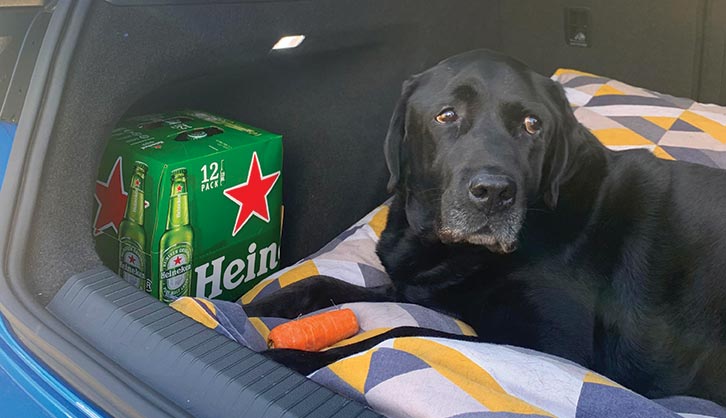
Additional storage options for caravans
Roof rails
You’ll be able to find roof rails for virtually every car that is on the market. These are incredibly useful, providing a safe method for transporting a wide variety of items, including bikes, boxes and skis.
I’d always recommend a custom-designed system over a universal or generic one – these will help to ensure the roof rail and other accessories are fitted securely to your car, something which is crucial. I had a rather scary incident with a pair of universal roof bars and a canoe, on a trip to Northumberland a few years back – not something that I’d want to repeat!
My preferred brand for roof rails nowadays is Thule. In my opinion, their roof rails are solidly made and brilliantly designed. While they may cost a bit more than other options on the market, they will last for years, and since I’ve been using them, they’ve never failed me. Both Thule and Halfords sell aerodynamically designed roof rails, which should both cut down the wind noise and limit fuel consumption. In some cases, they need bolting to the car, in other instances they come with built-in fixing and locking mechanisms.
Unsurprisingly, the more sophisticated systems will cost more, but this gives you convenience and a simple-to-operate product.
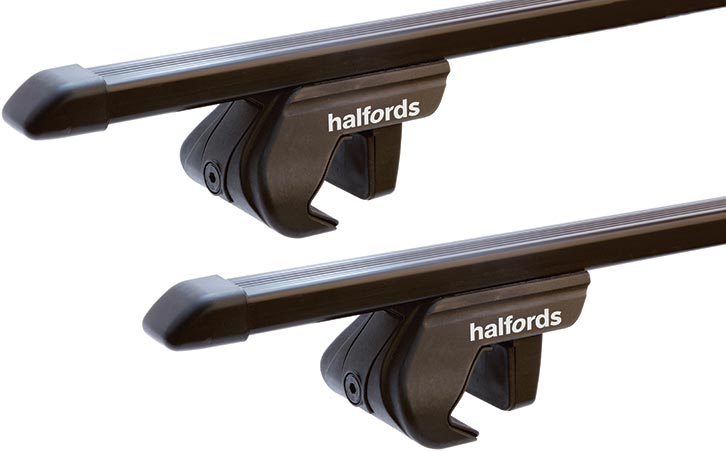
HandiWorld has a smart alternative to roof rails, the HandiRack. These easy-fit inflatable straps simply fit around the roof of the car and are then inflated with the supplied double-action pump.
They are ideal for transporting bags, canoes, surfboards and so on, and can be fitted or removed in a minute or two. Strong and durable, they can carry up to 80kg loads, yet deflate and fold up into a small drawstring bag when not in use.
Roof boxes
I think roof boxes are a great investment for caravanners and they’re something that I’m a big fan of. I love how they can free up space inside the car, which can be especially beneficial on those longer trips when you wouldn’t want to be crammed inside with lots of luggage. Available in hardshell and waterproof fabric styles, you’ll be able to find them in a variety of sizes and shapes.
My Thule Motion 800 roof box has proved its worth when we enjoyed tours to France in our caravan. It allows us to keep a variety of items stowed away in safety while we’re driving, as well as being a handy spot to place any dampy and sandy beachwear or similar accessories that we’ve used while by the sea, ensuring the interior of our tow car remains much cleaner and dryer.
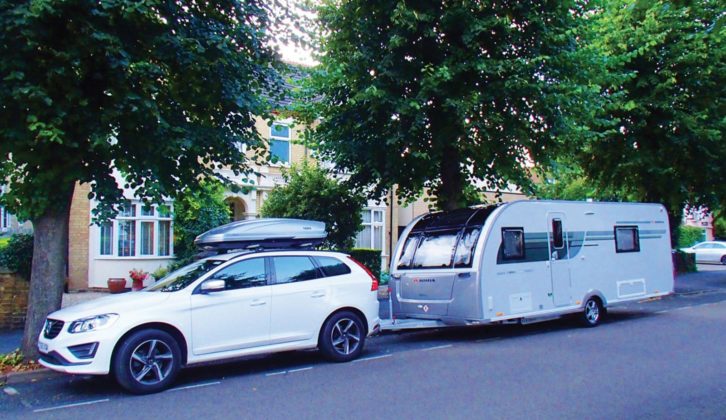
However, while I am a big fan of a roof box, I should point out the downside of owning a hardshell option – where will you store it? For instance, what do you do with it once you’ve arrived on site if you choose to remove it? And where will you keep it when you’ve returned home, post tour? It’s something to think about before you buy one. In my case, I don’t have a garage to store it and it was too big to fit inside my garden shed, so I instead had to hang it on a rail to the side. In short, don’t forget that you’re going to have to find room to store it for the vast majority of the year.
This is where a tough fabric bag such as the HandiHoldall comes into its own, as they can be folded up and stowed when you get home.
HandiHoldalls are available in three sizes – 175, 330 and 400 litres – and are made from a hardwearing 600D polyester, with waterproof PVC backing.
Don’t forget to factor the dimensions of your roof box into proceedings when you’re driving too – this could be a particular issue if you’re the owner of an SUV tow car, as you will not want to find your car is too big to drive under a car park barrier!
I keep a note of all of my caravan and vehicle dimensions, taped to my driver’s side sun visor for quick reference.
Bike racks
Bicycle carriers come in three main designs: tow car-roof mounted, rear window mounted and towball mounted (although of course, the latter can’t be used when towing).
Roof mounted is in many ways the easiest to use, because the bicycles don’t get in the way if you need to access the vehicle’s boot or hatch. It can be a stretch to place and retrieve bikes from the roof, however.
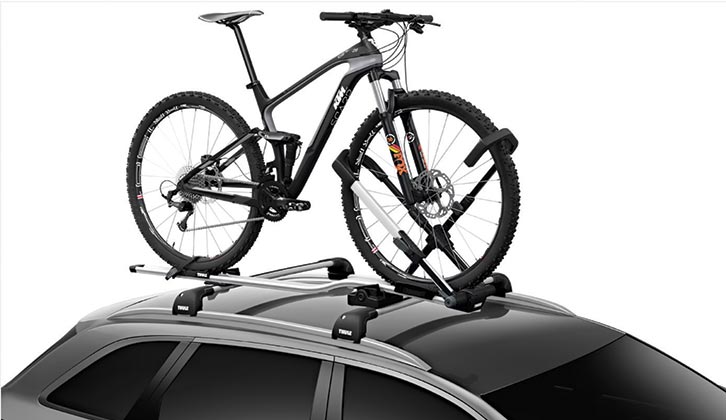
Some tourers have bike fixings fitted permanently on the back. However, experts I have talked to about this say these should be used with caution, because having extra weight on the back of the van can lead to a snaking caravan.
Internal storage
In addition to its external storage options, HandiWorld also produces a couple of very good items for use inside the tow car or caravan. I particularly like the Car Boot Organiser, a cleverly designed folding polyester storage system that’s as at home in underseat or underbed storage as it is in the boot of your car.
Likewise, the Car Back Seat Organiser is super useful for long towing trips, when you need to keep all of the children’s stuff close at hand in the back of the car.
The final word on loading a caravan
There’s more to loading your caravan safely than simply abiding by the 85% matching guideline.
Make sure that you know the weight of all your holiday kit and clobber, keep heavy items low and near the axle, and always secure the load carefully.
Take a look at my recent guide on caravan fridges too – you’ll want yours operating efficiently to ensure your food and drink stays chilled when you’re on tour.
Written with contributions from David Motton.
Future Publishing Limited, the publisher of Practical Caravan, provides the information in this article in good faith and makes no representation as to its completeness or accuracy. Individuals carrying out the instructions do so at their own risk and must exercise their independent judgement in determining the appropriateness of the advice to their circumstances. Individuals should take appropriate safety precautions and be aware of the risk of electrocution when dealing with electrical products. To the fullest extent permitted by law, neither Future nor its employees or agents shall have any liability in connection with the use of this information. You should check that any van warranty will not be affected before proceeding with DIY projects.
If you’ve enjoyed reading this article, why not get the latest news, reviews and features delivered direct to your door or inbox every month. Take advantage of our brilliant Practical Caravan magazine SUBSCRIBERS’ OFFER and SIGN UP TO OUR NEWSLETTER for regular weekly updates on all things caravan related.
